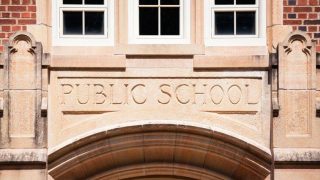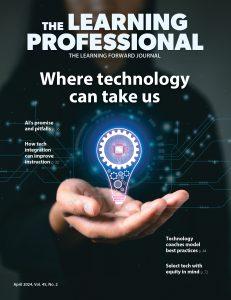What can educators learn from Olympians? Olympians model a playbook for success.
Fenwick Academy in Salem, New Jersey, is an example of a school that grows champion learners. Fenwick transformed its school culture, professional practice, and increased student achievement with its own playbook for success. Because of that, student reading scores at Fenwick have increased steadily for the past four years.
Syeda Woods became principal of Fenwick Academy five years ago. Woods is a graduate of the Learning Forward Academy Class of 2015. She had a vision for school success, created a learning culture, understood learning from the inside out, kept a focus on student achievement, implemented structures and strategies for improving instructional practice, and celebrated success.
Here’s the playbook the educators at Fenwick Academy used to guide them.
1. Have a vision of success.
Olympic athletes have a vision of success. They use mental imagery to help them perform at their peak and achieve their goals.
Educators at Fenwick Academy had a shared vision of success. Principal Woods led the community to visualize what the school could become. Learning goals for students and educators informed conversations about what classrooms would look like: caring, trusting, and accountable environments with a focus on literacy and student success. The goal for this pre-K-2 school was for 90% of 2nd-grade students to be reading above or on reading level upon entering 3rd grade.
Fenwick’s principal had an ambitious vision for the school. She also had the ability to visualize what Fenwick could be and a gift for attracting others to the vision. This shared vision grounded the school’s work.
2. Create a learning culture.
Olympians thrive in a culture of learning. They have the ability to recognize, understand, and manage their emotions. Champions use emotional intelligence to channel their energy toward results (Goleman, 1995).
Principal Woods created a culture of learning and service at Fenwick Academy. At its core were respect, empathy, trust, and accountability. Empathy is a high order of emotional intelligence. Seeing and listening through the eyes and ears of others were essential to Fenwick’s success. The school serves a diverse community, with many students living in poverty. The principal respected the diversity of voices, instinctively understanding that schools work best when all voices are heard and championed. Open hearts and minds were keys to the school’s success.
Fenwick Academy developed a culture of high expectations. The learning culture evolved from educators’ shared vision. Teachers demonstrated perseverance and passion in the classrooms, believing that every child could succeed (Duckworth, 2016).
3. Learn from the inside out.
Olympic athletes are driven from the inside out, motivated by their purpose, cause, and beliefs. What if students learned from the inside out? This meant making student engagement, motivation, and problem solving the starting point for learning.
Learning from the inside out connects with understanding the “why” of beliefs. Attentiveness to the “why” is a motivator, promoting understanding of goals and informing decision making (Sinek, 2011).
Principal Woods understood the “why” at Fenwick Academy and the importance of learning from the inside out. She led school change with a focus on student engagement, motivation, and learning. The principal cultivated human capital so the school community had a daily sense of shared purpose. Students, teachers, coaches, and paraprofessionals understood their roles in ensuring student success.
Principal Woods credits the staff with transforming the school. Teachers invested in refining their knowledge, skills, and instructional practice. The principal created learning structures so teachers had opportunities to collaborate with colleagues, practice the new strategies in the classroom, and receive coaching and feedback. The tipping point for change happened when teachers took responsibility for their own learning. They used their collaborative expertise to improve their practice and enhance student outcomes.
The result was a school learning culture that supported the assessment of instructional practice, a focus on student work, impact on student learning, and feedback about student progress. Fenwick educators successfully learned from the inside out by harnessing their collaborative expertise to improve student outcomes.
4. Focus, practice, finish, celebrate.
Learning takes deliberate, focused, consistent practice. Olympic champions know how to focus and how to practice. Focus is the ability to attend to internal and external fields of attention. Olympians focus on what will help them achieve their goals, then practice with precision to the finish.
Whether for an Olympian or a student, deliberate practice is an integral component of continuous improvement. Gold medal winner Rowdy Gaines said that his practice for the Olympics, spanning eight years and equivalent to swimming around the world, was for a race that lasted 49 seconds.
Focusing on student learning was central to Fenwick Academy. Schoolhouses are busy places with many distracters. Principal Woods served as the buffer so teachers could maintain their focus. The Fenwick Academy community understood the adage, “The main thing is to keep the main thing the main thing.” Their “main thing” was student achievement, centered on literacy.
Olympians understand the value of deliberate practice and incorporate it into their daily routines. Deliberate practice includes:
- Clearly defined goals;
- Full concentration and effort;
- Immediate and informative feedback; and
- Repetition with reflection and refinement (Ericsson, Krampe, & Tesch-Romer, 1993).
Fenwick implemented these elements of deliberate practice in everyday learning. The school had a clearly defined literacy goal. The staff gave its full concentration and effort to achieving this goal. The school implemented systems and structures to enhance instructional practice and improve student achievement, including a process for learning-focused feedback, reflection, and refinement. Repetition and reflection were also integral components of this continuous improvement cycle.
“Creating an atmosphere where everyone is learning and sharing strategies to improve instruction for students is always positive,” said Woods. “The lesson learned through this process is that the work is never finished. One must keep reflecting and make adjustments as needed for continuous progression in practice. When everyone is included in the process for the success of students, then everyone can celebrate together.”
Olympic champions and Fenwick Academy learners implemented these common guidelines to win their gold. How can your school learn from these lessons to improve student achievement?
References
Duckworth, A. (2016). Grit: The power of passion and perseverance. New York, NY: Simon & Schuster.
Ericsson, K.A., Krampe, R.T., & Tesch-Romer, C. (1993). The role of deliberate practice in the acquisition of expert performance. Psychological Review, 100(3), 363-406.
Goleman, D. (1995). Emotional intelligence. Why it can matter more than IQ. New York, NY: Bantam Books.
Sinek, S. (2011). Start with why: How great leaders inspire everyone to take action. New York, NY: Penguin Books.






